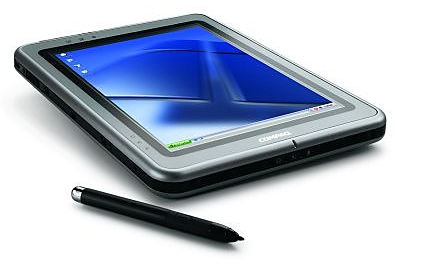A decade of tablet PCs: What have I learned?

Just over 10 years ago, at the end of January 2003, I bought my first tablet PC. It was an HP Compaq TC1000, a convertible slate format device. I was working as a consultant in an Anglo-US IT consulting organisation, and I'd decided that the pen and digital ink model in Microsoft's tablet PC vision was something that could make my working life easier.
The TC1000 with its removable keyboard and binder-like case rapidly became my standard mobile machine. It did have its flaws: the pen technology used by HP needed an AAAA battery (a size I never knew existed), additional memory compromised the airflow over the processor causing random thermal shutdowns, and the Transmeta processor never quite had the horsepower promised. Even so, there was something there.

Being able to take handwritten notes in a meeting changed relationships with colleagues. I wasn't hidden behind a screen, and the pen's early natural user interface made it easy to work and talk at the same time — especially as that was the year I changed career, becoming a freelance tech journalist. Note-taking became increasingly important, and the digital pen a key part of my workflow.
However the first generation of tablet PCs arrived before Intel's Centrino chipset, and while the Transmeta processor in the TC1000 was lower power than its Intel equivalents, power was an issue, and even with two batteries it wouldn't last more than a half day or so. I had to keep another machine at hand for writing, and that meant my backpack could get very heavy...
The second and third generation tablet PCs were built around Centrino, and power and performance were much improved. The TC1000 was replaced by one of the first third-generation devices, a Toshiba Portege M200. This was more like it, a true convertible laptop with a massive 1,400x1050-pixel screen. It's still one of the highest resolution laptops I've owned, and was an ideal machine for writing code, long articles, and of course, taking notes — using the then recently released Microsoft OneNote.
Unfortunately for the M200 it was built around NVIDIA's Go200 graphics card, and when Vista came along it got left behind, driverless and forgotten. There were hacks that let you get working, but you had to drop screen resolution to avoid crashes. It just wasn't worth the hassle, and mine stayed on XP until my next tablet PC came along.
The tablet PC was never very popular, and by the time I replaced the M200 there were very few devices on the market that weren't targeted at vertical markets. One manufacturer who kept the tablet PC faith was HP, and their TC4400 was a high-end laptop that just happened to be a convertible tablet. I suspect I would have been very happy with it for longer than the two or three months I used it, but sadly, somewhere over the Great Lakes, while I was working away, a carelessly reclined aircraft seat damaged the screen beyond repair. Like the Highlander, it was decapitated...
The dead TC4400 was quickly replaced by another HP tablet PC, a 2710p. A Core 2 Duo processor gave it plenty of power, and an extra slab battery gave it plenty of life. Over the years, I maxed out its memory, but never got round to replacing its tiny 80GB 1.8-inch hard drive. This was the tablet PC I'd been looking for, light and easy to use. I went through two sets of batteries, taking it from Vista to Windows 7. Then one day, at the Internet Explorer 9 launch event, I managed to spill water into a vent, damaging the display circuitry.
Its replacement was, not surprisingly, another tablet PC. This time, however, it was a consumer machine. HP had decided that the tablet PC should be part of its TouchSmart line of devices, and was mixing capacitive touchscreens with the familiar Wacom pen sensors. The tm2 had two points of touch along with a pen, in the familiar convertible form factor. It wasn't the lightest machine around (by a long way) but when you twisted the screen, the curved battery became a convenient grip.
I didn't use touch much. It never really worked for me with Windows 7, and it was only with the arrival of the Release Preview of Windows 8 that I started finding it usable. Two points were enough for Windows 8's gesture language, and while the screen resolution didn't let me use Snap, I found Windows 8 gave the aging machine a whole new lease on life.
Now here we are, a decade into my tablet PC ownership, and five machines down. The tm2 is working well, but it's starting to feel a little too bulky when I look at the current run of ultrabooks and lightweight Apple hardware. So you probably won't be surprised to learn that last week, on a trip to Toronto, I popped by a Microsoft Store and picked up a 64GB Surface Pro and a 64GB microSD card. After all, when a friend on Twitter asked what the Surface Pro was for, I'd answered, "For those of us who still miss the HP Compaq TC1000".
It feels like I've come full circle...